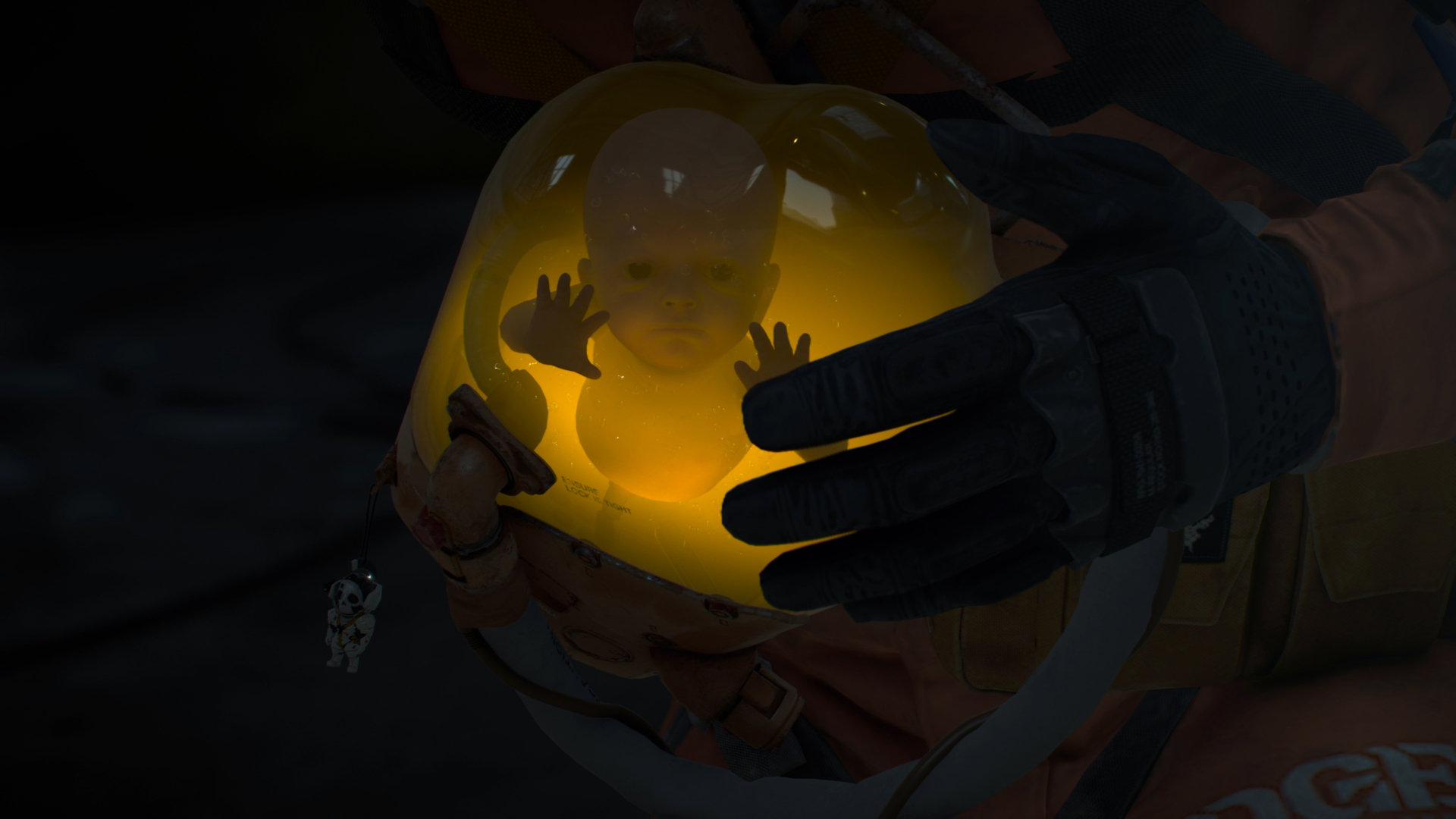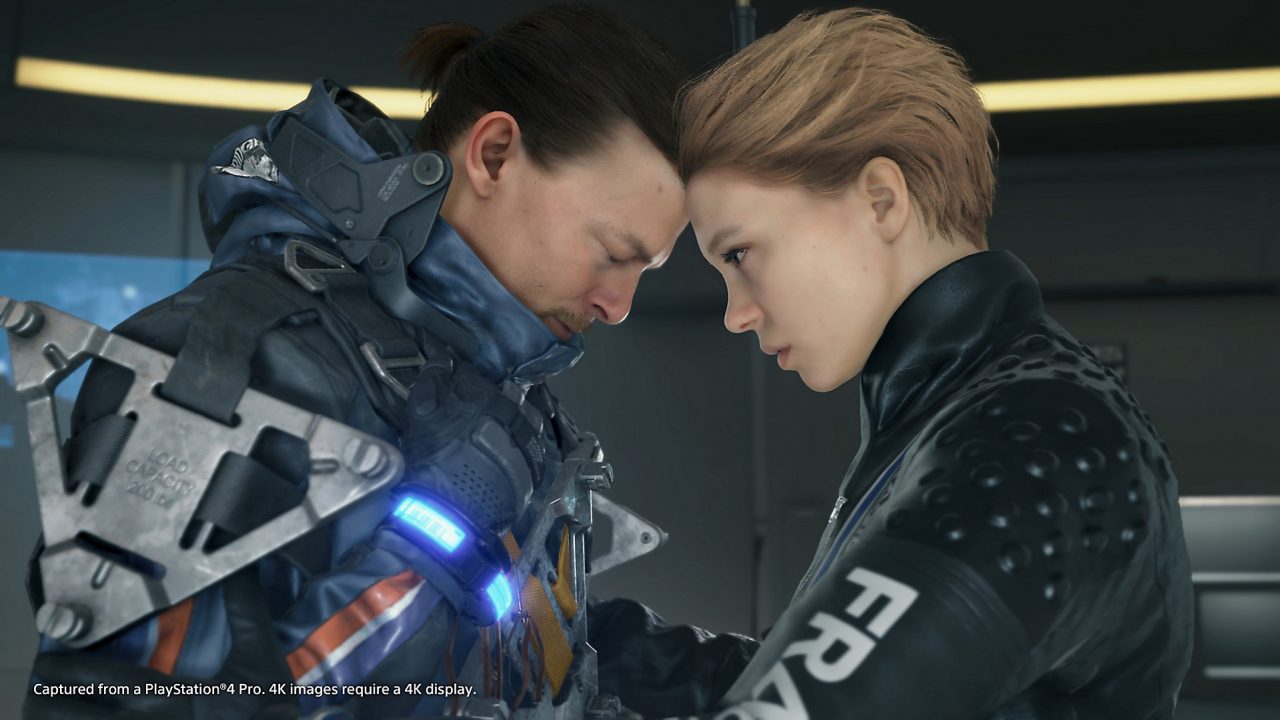Kojima's first game on his own, and it's pure Kojima at his best and weirdest.
gameplay 85 / story 90 / graphics 99 / sound 99
Oh, Hideo Kojima, what a strange human being you are. In creating Metal Gear Solid, you provided the world with arguably the single most meta video game series ever conceived. Yeah, you had other projects before, but that was where you really let loose your ambition and spoke your mind about how video games should be in your auteur brain. Or at least, that’s what we thought until Death Stranding came along and challenged what the public perceived a Hideo Kojima game to be. Yeah, he’s in full indulgence mode here, and that might be a bit of a turn off for some. I’ll admit, this is a difficult game to review, if only because it exists as a contradiction of itself. It’s severely tedious at times, but also relaxing in that same tedium. The mechanics are simplistic, yet the depth within that simplicity is seen in the combat and delivery system. The characters are much more subdued than in Metal Gear, but with it comes excellent performances that speak to the humans behind the characters more so than you’d think at first blush. Yeah, this intro is long, but believe me, it’s shorter than the one in the game. Did I enjoy it even after saying all this? Wholeheartedly, 100% without a doubt. Can I recommend it? Well…let’s find out.
The entire premise of the game centers around the eponymously named Death Stranding: a catastrophic extinction event that reshaped the entire world into one trapped in perpetual fear of death, though it mainly focuses on how the USA got affected. This is because when people die, they don’t necessarily leave the world. Rather, their “ghosts”, which are called BTs (Beach Things) get left behind to haunt the living and even drag them down to join in their purgatorial misery, connected only by the fact that they leave behind a beach: a sort of waiting room that’s literally a beach shore for many. Each death causes a “voidout”, which can be considered a mini-death stranding as it causes severe damage to the region the person died. There’s also the added danger of timefall: a scary form of rain that rapidly ages whatever it touches, including humans, to the point of decomposition and/or death. Due to the fear of another Death Stranding, the remaining survivors have chosen to hole up in the few remaining cities left in the USA, living day to day by utilizing delivery services to gather essentials like food, provisions, study materials, and whatever else Amazon can deliver for you lately.
You play as Sam Bridges, a delivery man whose sole purpose in life is to send packages back and forth to the remaining survivors. He’s unique because of a condition called DOOMS, which allows him not only to recover from voidout deaths (though not without leaving damage behind), but gives him the ability to sense BTs. However, on a new mission at the behest of the President of the former US, he’s tasked with the seemingly impossible: reconnect the remaining cities known as KNOTs via a chiral network through his deliveries in order to rebuild America. Seriously, that’s exactly how it’s put. To do this, he needs to travel cross-country through mountains, lakes, forests, and terrorist groups in order to achieve his goal, while at the same time avoiding the BTs that could potentially leave said areas as smoldering craters. But he won’t be travelling alone, as he’s asked to bring along a Bridge Baby (BB): a literal living baby in a womb-like jar that, when connected to his suit’s environmental systems, can show him exactly where BTs are, in order to aid him on his journey.
If you think I spoiled too much with this intro, believe me, I haven’t even come close to explaining the entire scope of this narrative. Such is the way of a Kojima game: no explanation will fully suffice without a manual at your side. I didn’t even cover half of the actual plot of the game, which I refuse to spoil lest you completely want to ruin one of the most interesting narratives of this year. Yes, it’s convoluted at times due to being both a sci-fi plot and a character study written by the most verbose auteur in gaming, and many concepts get over-explained multiple times, but…what else would you expect from Hideo Kojima, honestly? He somehow manages to make it all work out whether you decide to read into every detail or sail along for the main plot without going into specifics.
As far as characters go, there are at least two or three instantly recognizable faces and voices. Norman Reedus plays Sam Bridges, and he sells his characters stoic, yet caring nature all the way through the end. He might seem like a typical hard-ass action hero type, but underneath is a much deeper character whose motivations are both understandable and relatable. Another person you might recognize is Troy Baker, who plays Higgs, who you might this is just the antagonist, but…dammit, spoiler territory again. Let’s just say he’s at least entertaining to watch as he hams up the villainy of his character. Besides them, there’s Mads Mikkelsen from Hannibal playing Cliff Unger from the trailers, Tommy Earl Jenkins (awesomely named Die-Hardman), Guillermo Del Toro’s body with Jesse Corti’s voice (Deadman), and a slew of other lesser known actors and actresses. They all perform their parts well, and give commendable performances each with what they’re given. They really sell the fact that they now live in a broken world that, while resembling the former in some respects, has irrefutably changed so much that it’s no longer possible to think of going back to the way things were.
One thing that hasn’t changed is the fact that the world is still beautiful and that nature marches on despite tragedy. The landscapes you venture across are gorgeous to behold. Lush green rolling hills that drop into beautiful riverbeds surrounded by dried out desert pits that hide behind them the ruined remains of once great cities. That’s not even to mention the snow-capped mountains you travel through, the expansive coasts, and even some dense forests to make things more interesting. All of this is done with Guerilla Games’ Decima engine in a stunning display of technical prowess. Every water ripple, raindrop, and deep snow-covered footprint is lovingly detailed and just amazing to behold if you’re into that sort of thing. I did notice some occasional texture pop-in, as well as some random animation glitches from dead enemies, but that’s almost expected at this point, because no game comes out perfect.
And now we come to the most contentious piece of the larger picture: the gameplay. First off, I do have to say one thing: if you cannot get past the first ten or so hours of the game, then I’m going to have hard time explaining all the things I’m about to praise. But for the sake of argument, let’s get it out of the way. The introduction is one of the slowest that I’ve ever participated in. You know the phrase “walking simulator” and how it’s overused for a lot of titles? Well, it will feel like that for the introduction. This is where you get accustomed to the basics of traversing through the terrain, how to handle the cargo on your back, how to use basic tools to get through more hazardous areas, and the importance of the condition of your cargo. The problems are twofold: there’s no effective means of fast travel to reduce the monotony of going to the same places for the fiftieth time in a row, and the landscape of the intro area does not have too much variety in it. Therefore, getting past this section requires some patience and willingness to see the story through, as the final chapter in this intro chunk is where things really begin to pick up.
Once you reach the second – and by far largest – area of the game, the depth of the game begins to take shape. As stated before, the gameplay centers around delivering cargo to specific locations. You earn points based on cargo condition, distance traveled, and even time taken for some missions. Sam has a specialized backpack that can carry a limited number of items. Not by quantity, but by weight. Once you begin reaching your weight limit, it’ll start to limit how well you can travel, ranging from slowing you down immensely or being stacked so poorly that your balance is affected. Sam has a stamina and endurance meter, and it can only take so much before he becomes exhausted and needs a break. So, managing where your cargo goes is essential. You can add important items to your suit, place tools in the tool rack in order to reduce the weight on your back, and even put some items in your utility pouch to be used instantly and reduce the weight further. You can use your hands to grip onto your cargo for better balance at the risk of reducing your stamina faster, or carry items in your hands to prevent them from getting too damaged should you end up tipping over like an end-game Jenga tower.
There’s a lot around that can make your life more difficult though. From aggressive terrorist groups looking to steal your cargo for their own personal gain to the deadly BTs roaming the lands, to even the weather itself, there’s a lot to take caution with. The terrorists have their own posted areas that you occasionally must go past. You can either sneak past or fight your way through. Combat is the better option, however, as it opens the area up for easier travel if you can clear every enemy out. Combat is simple. You can either punch your way through or shoot them down. However, because every new death has severe consequences on the world, non-lethal tactics are encouraged. Because of this, using rubber bullets and bola shooters is really your best option to subduing your foes.
As for the BTs, they’re much more focused on stealth rather than direct engagement. Since you can only see them with the help of your BB – if your BB ends up getting too stressed out, it will become useless as it gets sick and unable to let you see where the BTs are. Because of this, you need to get close to them in order to see where their reach extends. They’re sensitive to sound, so you should crouch low and walk slow to avoid them. They’re vulnerable to specific weapon types that I won’t spoil here, but you won’t get them till you complete some deliveries, so get used to sneaking past BTs for most of the game.
However, this is also a game about making connections. Kojima calls this a “strand” game to create a new genre of open-world game. While I think he has a bit further to go in fleshing this idea out, here’s my interpretation of what that means. In delivering to more people, you increase the strength of their overall connection. Due to this connection, research and information can be easily traded between locations. As such, the more connections you make, the more items become available for you to create and use to ease the burden on your shoulders (yes, I’m proud of that one). These items range from stronger boots, varying types of mechanical legs that either increase your strength or get you through rough terrain easier, weapons of differing degrees of use, to even vehicles that you can load cargo into and drive to their destinations with a minimized risk of damage.
However, the terrain gets downright treacherous even with all these items at your disposal. So, did you know that this game has online features too? And unlike many other games, this one is entirely cooperative. No, you don’t encounter other players in the game delivering packages like you are. The way you encounter them is by what they leave behind. You’ll see their own ladders, vehicles, and other navigation tools, but then there are the truly helpful items. I’m talking bridges, post boxes, timefall shelters, and even an entire highway system that everyone provides supplies for. Due to this being a post-social media world, the currency you obtain (and can give) is in the form of “likes”. You can give likes to items you found useful throughout your deliveries, and others can do the same for your own constructions. If you gain enough likes through your travels, your title changes, allowing you to upgrade how well you can navigate, be it through increased carry weight or a larger pool of stamina. It’s all meant to encourage positive reinforcement through socialization, which makes it quite the accomplishment that because of this, I felt no need to be a violent psychopath against the NPCs in the game.
If you do need a break from running around delivering items and avoiding getting your stuff stolen, you can rest in the private rooms of some of the larger destinations. Here, your health is restored, your blood is taken (don’t worry, that’s a good thing), you get to shower, and you’re allowed the opportunity to…relieve yourself in order to create weapons against the BTs – I wish I was kidding. It’s also where you can destress your BB should it get too overwhelmed by the world outside. You can also read your emails here, which are often small stories from your delivery destinations that are both engaging and well-written. You can also listen to the atmospheric soundtrack while in here, as well as indulge in some of what I like to call “boredom antics”. Making faces in the mirror? Check. Poking your BB to make it smile? Check. Drinking a ton of Monster Energy® drinks (that was written with no irony) in order to temporarily increase your stamina once you leave? Oh yeah, there’s that too. It’s also in this room where you can fast travel to other private rooms that you’ve found either from in-game destinations or custom ones that other players have built. The only catch is that you must sit through every…single…animation in between in order to do so, which makes manual travel a less boring affair than fast traveling. Sure, you can skip them, but it’s still a chore.
Yeah, there’s the other good stuff to talk about: the amazing sound design, the wonderful soundtrack made by some unique indie artists, and the fact that this game is an avant-garde AAA title that was advertised as such in a way that is rarely even discussed. However, it’s time to get into the bad stuff. I’ve mentioned a few things here and there. The intro is ten hours too long, for one. There’s also the fact that the cutscenes can be a bit longer than some gamers are used to, and will feel extremely redundant if you don’t understand Kojima’s writing style. Plus, there’s the entirety of the gameplay itself. It is a lot of walking, despite there being a lot of unique means of traversal that make the deliveries feel less boring than you’re probably expecting. If that’s not the type of game you’re looking for, then I’m not sure what else I could say to convince you.
For me, Death Stranding was exactly what I expected from Hideo Kojima being off Konami’s leash. The excessive writing, the indulgent gameplay, the meditative nature of both the narrative and the interactions? All of it was an auteur playing around with his creation and giving us what his personal identity in gaming is. And what he delivered was a unique and engaging experience for me. Yeah, it gets repetitive at points, and it can feel hopelessly redundant at the best of times. But I expected nothing less from the master of strangeness himself. You might feel different and think this game is a ponderous waste of time that cares nothing for the player’s time and life. That’s to be expected with a game like this. How you respond is up to you. As for me, I look forward to more from Kojima, especially if it’s this unique and engaging.
Did you enjoy this review? Want to post your own review? Anyone can report the news, or post a review on gamelust.com, AND have a chance to become featured on our homepage! All you need to do is log in or register with us and add your voice today!
You must be logged in to leave a comment













